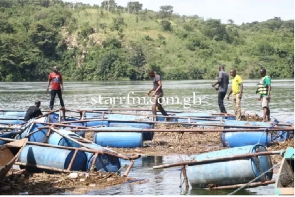The spillage of the Akosombo Dam has had a devastating impact on a crucial biosecured facility -Aquaculture Research and Development Centre (ARDEC) that has been in operation for over 30 years on the Volta Lake.
ARDEC which was established for research and the breeding of fish strains, has played a vital role in enhancing fish breeding in Ghana and the wider West African region.
It was originally established by the Food and Agriculture Organization (FAO) to support fish breeding projects.
Managed by the Water Resources Institute (WRI), the biosecured facility was the birthplace of the Akosombo Strain of the Nile Tilapia.
This particular strain emerged from a collaborative project titled “Breeding and Selection of Oreochromis Niloticus for Faster Growth,” which began in 1999 in partnership with the WorldFish Centre.
The project was part of a selective breeding program that led to the development of two fast-growing strains of the Nile tilapia, an economically significant fish native to many parts of Africa: the Akosombo and ‘Abbassa strains.
These new strains of fish were remarkable, growing approximately 30% faster than the most common commercial strains.
This advancement held significant promise for food security and increased earnings for farmers across Africa.
Over the years, the Water Resources Institute of Ghana continued its efforts to develop improved strains of tilapia, in collaboration with the FAO of the United Nations, at the Aquaculture Research and Development Centre (ARDEC)
situated on the Volta Lake.
The institute was actively working on the 12th generation of the Akosombo strain of tilapia, specifically tailored for the West Africa sub-region.
However, the recent spillage of the Akosombo Dam has almost shattered this long-term endeavor.
The fast water flow caused the tilapia to escape from their containment, with many fish perishing in the process.
Officials from the Water Resources Institute, gathered at the Abume community where they were attempting to salvage their cages carried away by the floodwaters, are now appealing for urgent support from the government to safeguard the remaining fish breeds.
Some residents were also busy stealing the fish variety being used for research and not cleared for human consumption creating serious safety concerns.
WRI brought armed police to stop the residents.
Officials of WRI blame Poor communication and institutional collaboration on the part of VRA regarding the spillage of the dam for the devastation.
The destruction of this biosecured facility represents a significant setback for fish breeding research and development in the sub- region, underscoring the importance of assessing and mitigating the broader consequences of dam spillage.
They urged the Member of Parliament for Asuogyaman Thomas Ampem Nyarko who coincidentally arrived at the scene while visiting affected communities to make a strong case on the destruction of the facility on the floor of Parliament for urgent attention.
In Ghana, regulations mandate the use of the Akosombo strain in tilapia farming.
However, new trials indicate that switching to the Genetically Improved Farmed Tilapia (GIFT strain) developed in Asia in the 1980s could yield significant growth benefits.
To prevent unforeseen consequences, it is imperative to follow appropriate procedures and effective national regulations.
Collaborative efforts among industry stakeholders, government agencies, academic and research institutions are necessary to establish a suitable protocol for the import, sustainable production, supply, and management of exotic fish species.
Devastation by the Spillage
Asuogyaman district in the Eastern region has been struck by a catastrophic flood disaster as a consequence of the ongoing spillage from the Akosombo Dam.
The Volta River Authority (VRA) initiated controlled spillage of the Akosombo and Kpong Dams on September 15, 2023, due to a consistent rise in water levels upstream of the Akosombo Dam, primarily caused by heavy rainfall.
In recent days, this controlled spillage has intensified to address the persistently rising water levels, which posed a significant threat to the dams.
As of October 10, 2023, the water level in the Volta Lake measured 276.65 ft, marking an increase of 0.22 ft compared to the previous day.
The spill situation reached 2,547 m3/s, while the turbine flow for power generation stood at 1,416 m3/s. The expected total discharge was estimated at 3,986 m3/s.
Tragically, this spillage has led to catastrophic flooding in numerous fishing communities, displacing hundreds of residents.
Affected areas include Kokonte Kpedzi, Abume, Kudikope, Ahenbrom, Dzidzokope, Mama kope, and many others.
Numerous houses have been submerged, and fish cages containing substantial quantities of fish have been swept away, with others resulting in the death of fish due to high turbidity and shock.
In Kokonte Kpedzi, seven children have been reported injured, several houses have collapsed, and fish cages were carried away by the surging waters.
Simon Amedzake, a local fisherman, expressed the dire situation, stating, “Thousands of fishes are dead and being harvested. We used cables to hook some of the cages to trees to salvage them from being carried away. In fact, the situation is bad. Many investments have been lost, and sources of livelihood have been disrupted. We need VRA to compensate us because they didn’t inform us.”
Member of Parliament for Asuogyaman, Thomas Ampem Nyarko, expressed shock when he visited the affected communities to assess the extent of the damage on Wednesday, October 11, 2023.
He called upon the National Disaster Management Organization (NADMO) to collect data on the affected individuals and assess the extent of losses to build a strong case for emergency relief intervention
Business News of Friday, 13 October 2023
Source: starrfm.com.gh
Akosombo Dam spillage destroys biosecured facility vital for fish breeding
Entertainment
















